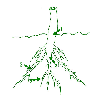Various alterations of the neck
and the portion of the rod close to the ground
In tomatoes, the area in contact with the soil (figures 1 and 2) can undergo various alterations which may have biotic or abiotic causes. Figures 3 to 6 show, for example, a few lesions characterizing parasitic attacks on the neck.
 |
 |
 |
| Figure 1 | Figure 2 | Figure 3 |
 |
 |
 |
| Figure 4 | Figure 5 | Figure 6 |
In the presence of such symptoms, you can make the following assumptions:
- either parasitic
- Botrytis cinerea (figure 5)
- Didymella lycopersici
- Fusarium oxysporum f. sp. root-lycopersici
- Phytophthora spp. (figure 3)
- Rhizoctonia solani (figure 4)
- Sclerotinia sclerotiorum
- Sclerotium rolfsii (figure 6)
- Didymella lycopersici
- Fusarium oxysporum f. sp. root-lycopersici
- Phytophthora spp. (figure 3)
- Rhizoctonia solani (figure 4)
- Sclerotinia sclerotiorum
- Sclerotium rolfsii (figure 6)
- either non-parasitic
- Corky collar and pivot
- Various phytotoxicities
- Various phytotoxicities
As we suggested in the previous sections, the crown can be affected by several microorganisms (in particular fungi) more or less able to attack both this organ and the roots of the tomato. Many of them concern young seedlings in the nursery (causing damping off in particular), such as seedlings after planting.
It should be noted that the collar, part of the stem located at ground level, is particularly vulnerable, in particular to water stress and to some "specialized" fungi such as Sclerotium rolfsii. Thus more or less extensive alterations, sometimes completely encircling the rod, characterize a problem at the neck. In many cases, the sap flow will be disturbed, resulting in yellowing and / or wilting more or less reversible.
Note that it is not always easy to identify the origin of an alteration of the neck; it will often be necessary to bring a sample to a specialized laboratory in order to be able to observe the specific signs of one or more pests on the neck.





